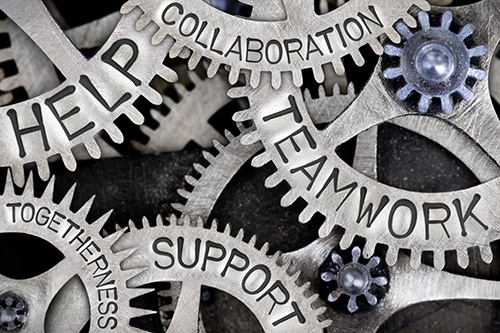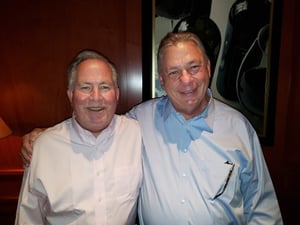
A major reason the Finished Vehicle Logistics (FVL) division of Supply Chain Management continues to grow exponentially at AIAG is due to the support and guidance provided by our volunteers and specifically those leading the FVL Oversight Committee.
Led by committee chair, Bill Kerrigan (vice president SSA Marine, Automotive) and co-chair, Marty Colbeck (East Coast director sales/marketing, Auto Warehousing) the Oversight Committee assists the FVL division in launching initiatives that bridge gaps and reduce barriers in the supply chain, resulting in overall industry process improvements.
The FVL Oversight Committee is made up of finished vehicle logistics leaders from automotive OEMs, transportation service providers (ocean, rail and haul-away), marine terminal managers, port authorities, and port processors — all supporting the effort with Bill and Marty at the helm.
In the following interview, Bill and Marty share their perspectives on FVL and where AIAG members should focus attention right now.

AIAG: How long have you been involved with AIAG and the logistics industry?
Colbeck: At least 20 years. I was one of the original members of the Standardization of Damage Coding and the EPOD initiative. I have been involved in the logistics industry for over 41 years, starting with the A.B. Volvo Purchasing office in Detroit then advancing to Chrysler Motors with assignments in damage prevention, international supply, import vehicle purchasing and operations, and finishing my career at Chrysler as the manager of vehicle operations for North America in 2007.
Kerrigan: I’ve been involved in AIAG 16 years, and it’s been a good run. I believe in what AIAG does. AIAG changed the whole picture on the inbound side. We’ve only been working on the FVL/outbound side since 2012. AIAG breaks down walls, gets people talking to each other, and helps define our industry’s best practices.
I joined SSA in 2015 after directing my own consulting company since 2000. I have over 38 years of experience in the transportation industry, including executive positions with a major ocean carrier and terminal operator.
AIAG: What have been the biggest changes in the FVL segment of the industry over the past several years?
Kerrigan: FVL is worth billions of dollars, but we haven’t paid enough attention to it in our industry. Dealers are often the tail wagging the dog. Here in North America, we build cars for stock; the Europeans build cars to order, which means they have no big lots to store costs. The U.S. would be better to follow the European model – and I may get in trouble for saying that — but it’s not so off track when you consider that the Millennials are going online and ordering the exact car that they want. We have to stop building cars for storage.
Colbeck: The biggest thing for FVL is the speed that things are changing. Change used to happen over the course of a year and now it can happen overnight, specifically in electronic communications. The new faces in our supply chain used to be there for a career, and now automotive seems to be a stop on the way to the next job. That is good and bad. New faces have new ideas and want changes now. What they do not have is the history of why things are the way they are now. I think we need to do a better job of planning and succession.
AIAG: What are the biggest opportunities for the industry?
Colbeck: Finding a new sense of working together to improve the supply chain. A realization that the supply chain is a cost center that has the ability to reduce costs by working together to refine processes and communication between the individual transportation modes.
What happens at the ports directly affects what happens to the truckers and to the railroads and to the processors. What happens on the rails directly impacts the truckers and plants and the dealers — that is why it is called a chain — the industry is linked together. Working together as a supply chain industry, there are economies of scale. When we get together and increase the throughput, everybody can win. If we stay in silos only looking for our own commercial advantage, no one is going to win.
Kerrigan: And technology is an opportunity for sure. On the inbound side, we suffer from a lack of visibility. On the outbound side, it’s even more important. You have the option of changing deliveries midstream if you can get a mix of OEMs on the same truck or railcar. For example, if a car comes out of the plant and is heading to the Michigan UP, you might wait for the delivery truck to get full. Now, different OEMs can add inventory to the same truck. Technology helps optimize things for everyone.
The next stage is artificial intelligence, which will tell the transporter which is the better route or time of day to transport. That’s what’s coming next. There are still certain limitations because humans are driving the trucks. The opportunity is in looking at network design.
AIAG: What changes would you make to the strategic direction of the FVL industry?
Colbeck: Use the information that is already available and share it across all modes of transportation. Work together to improve processes. Reduce the transit times and non-value-added dwell and everybody wins. We need less damage moving from one yard to another and a reduction of sitting in lots waiting to be moved for different reasons. We need a better utilization of equipment, and as a result, we will lower costs because of the ability to plan better. And finally, we should treat long-time logistics employees as subject matter professionals and compensate them accordingly.
Kerrigan: We are here to improve the quality of finished-vehicle transport. We aren’t here to decide what the industry needs to address. We ask, “What do you want to happen?” We need more voices to speak up, to look at their inbound and outbound supply chains. It’s hard to get people’s time and get them involved as volunteers.
We need to be more collaborative. There are only about nine global ocean carriers, six railroads, and a ton of truckers. We have fixed assets for transportation, and we have to use those resources wisely. We have to decide if we are a North American domain or a global domain.
AIAG: What are the biggest obstacles or threats?
Colbeck: Fear. Fear that sharing data will hurt and not help. I may give a competitor a strategic advantage if they know what time that vehicle will really be unloaded or arriving or that there is a delay in transit. Fear that systems may be compromised. If I give you access to my data, how do I know you won’t hack into my system and hold it for ransom or corrupt my data base?
Kerrigan: Gas is very expensive and adhering to new fuel standards is very expensive. No one wants to absorb the cost. The new fuel and CO2 standards are going to change the whole dynamic for ocean carriers. Now, they have to burn lower sulfur-grade fuel when they are a certain distance from the shore.
Also, OEMs are hesitant to collaborate. Is logistics a competitive advantage or not? If you think it is, then you might not want to share information with your competitors. But if you are making cars and throwing them out on the lot, you don’t really care when they get there. We can’t decide what the OEMs’ strategy should be…that’s up to them.
AIAG: How would you describe the industry culture?
Colbeck: Opening up. The new management is starting to realize the value of working together and sharing data. Millennials are starting to look at supply chain as a career, not a death sentence.
Kerrigan: I’d describe it as too old. We haven’t done a good job with knowledge transfer. Every conference I attend, the people are too old and all men. We haven’t done a good job of recruiting people into the logistics side of the industry. You say “logistics” to young people, and they pause and say, “What’s that?” Every time I hear of a layoff, I think, “There goes the knowledge with them.”
AIAG: How can the AIAG FVL Oversight committee drive best practices for the electronic automotive age?
Colbeck: Encourage more and younger participation from the OEMs and the carrier base. Without hard targets and a consensus for going forward, we will never break the old silos of information and processes. We need new and fearless participation, a group not afraid to make mistakes in the name of progress. The older members need to listen and be patient.
Kerrigan: I encourage companies to let their younger people get involved at AIAG. Even volunteering one to two hours a month will make a difference. We need the young people to help drive best practices for the electronic automotive age.
Our role is the awareness – to make them aware of what’s going on. But we have to get people into the same room to define the path forward. AIAG doesn’t define the path. It’s up to the members to do that.
Learn more about AIAG membership at www.aiag.org/membership or get in touch with our team: AIAGMemberServices@aiag.org.


